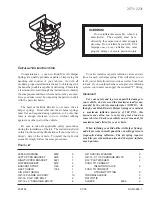
158
Starting and driving
Economical motoring
Factors affecting fuel
consumption
The fuel consumption of a car is greatly
affected by driving conditions, climate, road
conditions, speed, driving technique, and so
on.
Running-in
Fuel consumption may be somewhat higher
during the running-in period (the first
3100-4350 miles/5000-7000 km) than
stated values.
Weather conditions
Summer temperatures give better fuel
economy that winter ones. The difference
can be as much as about 10 per cent. Con-
sumption increases in cold weather
because the engine takes longer to reach its
normal operating temperature. The trans-
mission and wheel bearings also take
longer to warm up. Even distance affects
consumption: short journeys of three to
five 3 to 5 miles (5-8 km) do not give the
engine enough time to reach its optimum
temperature. Wind conditions also have a
marked effect on consumption.
How to read the diagram (the following
example relates to petrol-engined cars):
If fuel consumption with the engine at normal
temperature is 28 mpg (10 l/100 km), the
actual fuel consumption 3 miles (5 km) after
the engine has started from cold will be:
– 23.5 mpg (12 l/100 km) at outside temp.
of +20 °C (increase of 20
%
).
– 17.7 mpg (16 l/100 km) at outside temp.
of 0 °C (increase of 60
%
).
– 14.1 mpg (20 l/100 km) at outside temp.
of –20 °C (increase of 100
%
).
It is clear from the diagram that both dis-
tance driven and outside temperature have
a significant impact on fuel consumption,
after a cold start.
If the car is normally driven on short jour-
neys of 3 to 5 miles (5–8 km), for example
to and from work, the average consumption
will be 60-80 per cent above the normal
level.
Driving techniques
• To achieve the best running economy,
with regard to fuel consumption and gen-
eral wear, the car must be serviced regu-
larly.
• High speed, unnecessary acceleration,
frequent braking and much changing
down all give higher fuel consumption.
• Frequent gear changing in traffic, starting
in cold weather, the use of studded tyres
and roof racks, and towing a caravan all
increase fuel consumption.
Percentage increase in fuel consumption
of engine starting from cold compared to
engine at normal temperature
460_OM_MY09.book Page 158 Wednesday, April 2, 2008 10:32 AM
Summary of Contents for BLS
Page 14: ...14 This page has been left blank 460_OM_MY09 book Page 14 Wednesday April 2 2008 10 32 AM ...
Page 261: ...261 Notes Notes 460_OM_MY09 book Page 261 Wednesday April 2 2008 10 32 AM ...
Page 262: ...262 Notes 460_OM_MY09 book Page 262 Wednesday April 2 2008 10 32 AM ...
Page 263: ...263 Notes 460_OM_MY09 book Page 263 Wednesday April 2 2008 10 32 AM ...
Page 264: ...264 Notes 460_OM_MY09 book Page 264 Wednesday April 2 2008 10 32 AM ...
Page 265: ...265 Notes 460_OM_MY09 book Page 265 Wednesday April 2 2008 10 32 AM ...
Page 266: ...266 Notes 460_OM_MY09 book Page 266 Wednesday April 2 2008 10 32 AM ...
Page 267: ...267 Notes 460_OM_MY09 book Page 267 Wednesday April 2 2008 10 32 AM ...
Page 268: ...268 Notes 460_OM_MY09 book Page 268 Wednesday April 2 2008 10 32 AM ...
Page 269: ...269 Notes 460_OM_MY09 book Page 269 Wednesday April 2 2008 10 32 AM ...
Page 270: ...270 Notes 460_OM_MY09 book Page 270 Wednesday April 2 2008 10 32 AM ...
Page 271: ...271 Notes 460_OM_MY09 book Page 271 Wednesday April 2 2008 10 32 AM ...
Page 272: ...272 Notes 460_OM_MY09 book Page 272 Wednesday April 2 2008 10 32 AM ...
















































